Guide to Selecting the Perfect Bedroom Light Fixtures
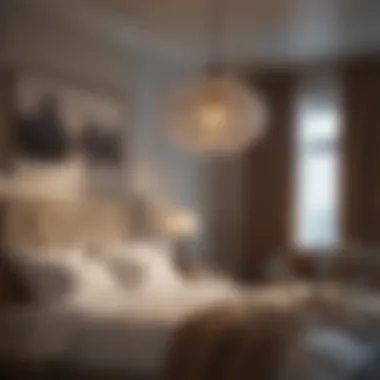
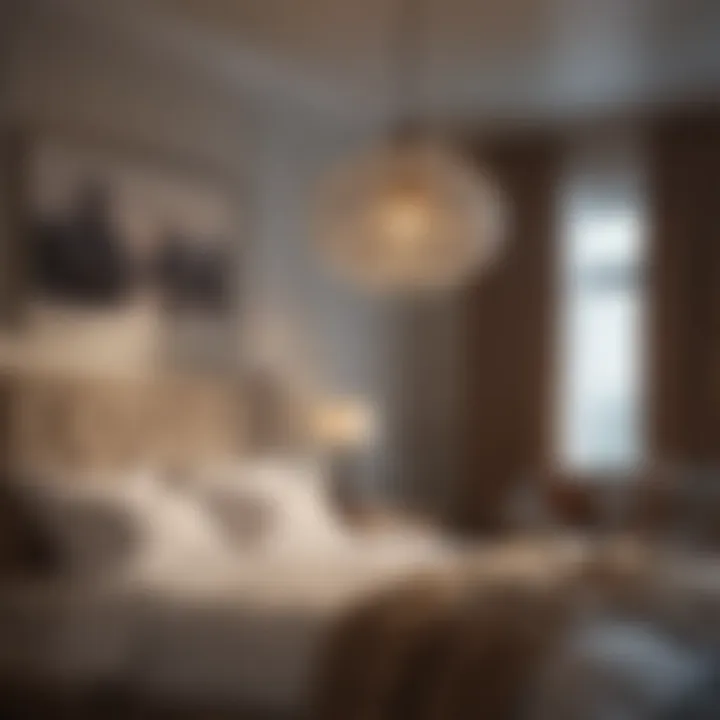
Intro
Lighting is often an afterthought in bedroom design, yet it can significantly influence the look and feel of your personal sanctuary. The correct light fixtures not only illuminate your space but also contribute to the atmosphere, turning a simple room into a cozy retreat. This guide probes into various bedroom light fixtures, aiming to enlighten homeowners and housewives alike on how to achieve ideal illumination.
Why Light Fixtures Matter
Choosing the right light can be the difference between a drab space and a warm, inviting environment. Fixtures come in all shapes and styles, each providing different functionalities and aesthetic appeal. As you dive into this guide, consider how lighting reflects your personality and complements your decor. It’s not just about visibility; it’s about creating a mood that resonates with your lifestyle.
So, What's on the Agenda?
In the following sections, we’ll explore:
- Trending Styles
- Color Palettes
Here, we'll touch on modern minimalism and cozy rustic styles. Understanding these will enhance your room's aesthetics. We'll also review how color choices, from calming neutrals to bold accents, can affect your space.
Let’s get started and shed some light on finding the perfect bedroom light fixtures.
Preamble to Bedroom Lighting
Lighting can completely transform a bedroom, turning a dull retreat into a cozy sanctuary. This section pulls back the curtain on the importance of bedroom lighting, highlighting how it affects not just the aesthetics of a space, but also the overall feel and function of a bedroom.
When we think about a bedroom, we often focus on elements such as color schemes, furniture, and decor. However, without the right lighting, even the most beautifully styled bedrooms can fall flat. The nature of light changes the perception of colors and textures, and it can create mood and intimacy. It's like adding that secret seasoning to a well-cooked dish; it's simply there, but when it's missing, you can tell.
Moreover, effective lighting has a multitude of benefits beyond just beauty. It plays a crucial role in daily activities, from reading a bedtime story, to preparing for the day, or creating a serene atmosphere for winding down in the evening. There are different types of light sources, such as ambient, accent, and task lighting, each serving distinct functions while contributing to the overall impression of the room.
Understanding the specifics of how light operates in a space is essential, particularly in creating a balanced environment that promotes relaxation and rejuvenation. It’s not just about throwing some bulbs in sockets. Thoughtful placement, intensity, and color temperature of light fixtures can miraculously affect how well we sleep and how energized we feel in the morning.
In essence, diving into the sphere of bedroom lighting is not just a matter of bulbs and fixtures; it’s about crafting an atmosphere that resonates with your personal style and practical needs. This section serves as a vital base for us to explore the varieties of light fixtures available and how they can be the cornerstone of your bedroom's overall design.
Understanding the Role of Light in Bedrooms
Light has a very interesting role in any residential space, especially in a bedroom. The position of a light fixture can either make or break the feeling of a room. Just imagine entering a dark, gloomy space; it can instantly evoke feelings of sadness or discomfort. Conversely, a well-lit room can foster emotions of calm and happiness.
Different lighting types create different emotional atmospheres. For example, warm tones are known to enhance relaxation and make a space feel intimate. Conversely, bright white light can be invigorating, perfect for tasks that require focus.
Research has shown that, in bedrooms, warm lighting close to the color temperature of sunset (about 2700 Kelvin) can aid in the body's production of melatonin. Therefore, when choosing bedroom lighting, it's not just about aesthetics; it involves understanding how light influences our biology.
Key Elements of Effective Lighting Design
Creating an effective lighting design goes beyond merely selecting stylish fixtures. There are a few key elements to consider:
- Layering: Combining ambient, task, and accent lighting to create depth and interest.
- Control: Dimmers or smart bulbs that allow you to adjust brightness according to the time of day or activity.
- Functionality: Ensuring different light sources are placed to accommodate the activities taking place in the bedroom.
- Harmonizing with Decor: Select light fixtures that complement the overall style of the room, tying together colors, materials, and motifs.
Remember: Lighting design is about balance and harmony. When done well, it will enhance your living space without drawing too much attention to itself.
Types of Light Fixtures for Bedrooms
Selecting the right light fixtures for a bedroom might seem like a simple task, but it can significantly influence not only the room’s aesthetic appeal but also its functionality. Fixtures do more than just illuminate; they set the mood and can even affect your well-being. It’s essential to think about how different types of light fixtures serve distinct purposes, such as providing ambient, task, or accent lighting. Each type enhances the character of the room, making it a sanctuary or a lively space, depending on your needs and taste.
Chandeliers: Elegance and Drama
Chandeliers can transform any bedroom from mundane to magnificent. They add a touch of elegance and flair, acting as a statement piece that draws the eye upwards. Whether it’s a bohemian beaded chandelier or a sleek modern design, the options are plenty. Their beauty lies in their versatility; a well-placed chandelier can enhance both high ceilings and cozy nooks.
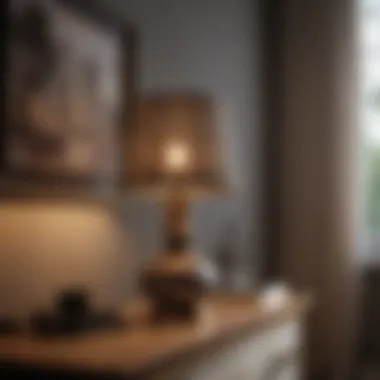
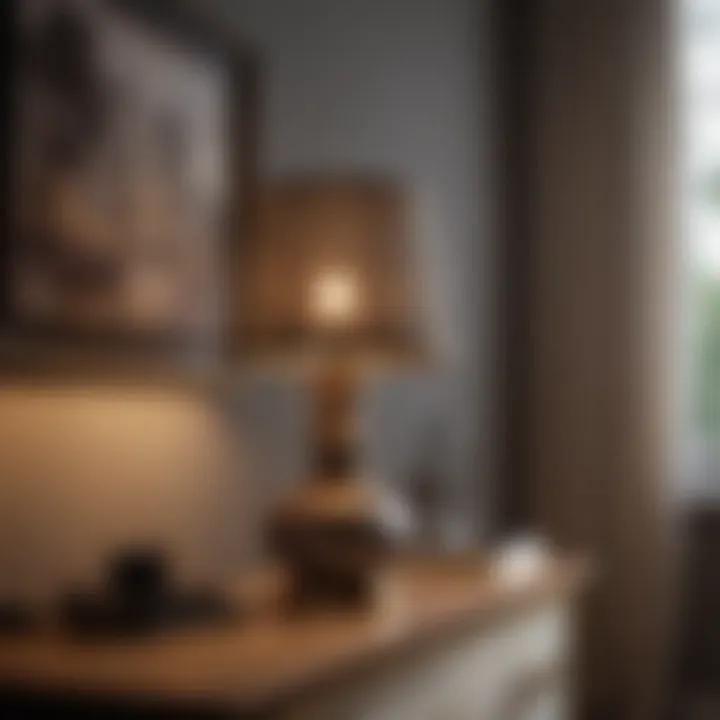
Moreover, chandeliers often have dimming options, allowing you to control the brightness. This versatility helps create a relaxing atmosphere at night while being bright enough for activities like reading. The soft bouncing light off the ceiling can create an ethereal ambiance that’s soothing after a long day.
"A stunning chandelier not only provides light but becomes an artwork that infuses personality into your space."
Wall Sconces: Space-Saving Solutions
Wall sconces are ideal for optimizing space without sacrificing style. These mounted fixtures come in a wide array of designs—from rustic to contemporary—making it easy to find a pair that suits your decor. They can be symmetrical, flanking the bed for convenience, or even used in corners to add depth to your room.
Sconces provide focused light, which means they are perfect for reading or tasks in bed. Plus, by choosing dimmable sconces, you can adjust the brightness according to your mood or activity, creating just the right setting for winding down.
Table Lamps: Versatility and Style
Table lamps are the unsung heroes of bedroom lighting. They are incredibly versatile, serving both functional and decorative purposes. Whether it’s a sleek modern lamp or a vintage ceramic piece, table lamps come in all shapes, sizes, and styles. Their prevalence on nightstands or dressers provides not only light but an opportunity to express personal style.
In terms of functionality, these lamps are ideal for creating a warm and inviting atmosphere. They can act as accent lighting or serve specific needs, like illuminating a book or a cozy corner for relaxation, thus enriching your bedroom experience.
Floor Lamps: Adding Height and Character
Floor lamps bring a unique dimension to a room. Their height allows them to fill empty spaces, giving the room a sense of balance and character. Whether it’s a mid-century arc lamp or a chic tripod floor lamp, the right choice can add personality and charm to any bedroom.
They usually offer a broader beam of light and can be adjusted easily, making them suitable for various activities, from reading to relaxation. With the right placement, a floor lamp can draw attention to artwork or architectural features, contributing to the overall design.
In summary, when considering the types of light fixtures for bedrooms, it’s crucial to be aware of how each option presents unique benefits. From chandeliers providing drama to sconces acting as space-saving solutions, the right choice can optimize light, enhance style, and create the desired atmosphere.
Factors to Consider When Choosing Bedroom Fixtures
Choosing the right bedroom light fixtures can make all the difference in creating a welcoming and functional space. It's not just about aesthetics; the right lighting complements your personal style and serves your needs effectively. When considering which fixtures to select, there are several important factors that should shape your decision-making process.
Personal Style and Room Aesthetics
When it comes to lighting, personal style plays a pivotal role. Your fixtures ought to reflect your tastes, contributing to the overall aesthetic of the room. Consider your decor style—are you going for a modern vibe, a bohemian flair, or classic elegance? For instance, a sleek, chrome finish may work wonders in a contemporary setting, while a vintage brass fixture can add warmth and character to a rustic room.
Moreover, the color scheme and materials of your bedroom also matter. Transforming a dull space into a cozy sanctuary can be as simple as selecting fixtures that resonate with your existing palette. Light fixtures can also introduce unexpected textures, like woven rattan or polished wood, enriching the visual narrative of your space.
"The right light fixture is like the icing on the cake; it ties the whole room together."
Brightness Levels and Functionality
Next, consider the brightness levels and the functionality of the fixtures. Different areas in your bedroom will require varying degrees of light. For instance, if you love to read in bed, installing adjustable bedside lamps can provide focused light without disturbing your partner. Meanwhile, a brighter central fixture might be ideal for cleaning or getting dressed.
Taking into account the wattage and type of bulbs used is essential. Certain LED bulbs are great for achieving bright daylight-like illumination, while others mimic the soft glow of incandescent lights. Following this, think about using dimmers. They allow you to control the light intensity, setting a calming atmosphere for relaxation or elevating brightness for productivity.
Energy Efficiency and Sustainability
In today's world, being mindful of energy consumption is a necessity, not a luxury. Opting for energy-efficient fixtures contributes significantly to lowering your electricity bills and reducing your carbon footprint. LED lights, for instance, can last up to 25 times longer than traditional incandescent bulbs, lessening the need for frequent replacements.
When choosing fixtures, it's also wise to consider their production and design regarding sustainability. Look for manufacturers who adopt eco-friendly practices and materials. Selecting fixtures crafted from recycled or sustainably sourced materials can help you create a beautiful space while being kind to the planet.
In sum, when selecting fixtures for your bedroom, consider how these fundamental aspects—personal style, brightness, and eco-friendliness—intertwine. They will guide you to make choices that not only enhance the functionality and aesthetics of your space but also resonate with your values.
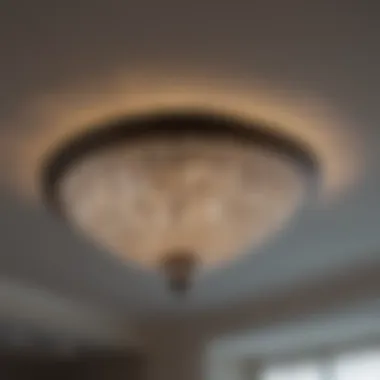
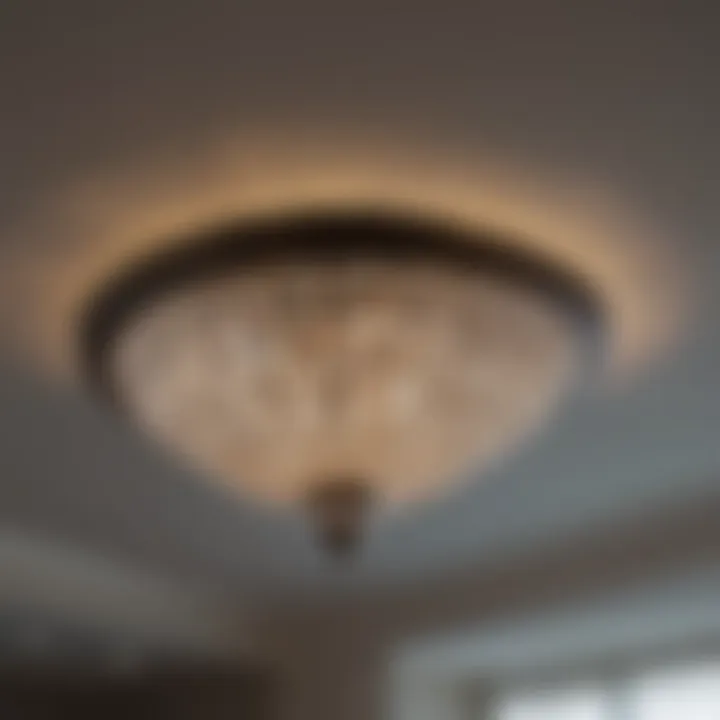
The Impact of Lighting on Mood and Well-Being
Lighting is more than just a practical need; it's a key player in shaping how a space feels. Especially in bedrooms, the right lighting can influence sleep quality and overall well-being. When people enter a room, they often respond instinctively to its ambiance, which is largely dictated by the light. Whether it’s a soft glow from a bedside lamp or the bright illumination of a chandelier, the choices we make in lighting can significantly affect mood and emotional state.
Consider this: bright lighting is often invigorating and stimulating, perfect for energizing one's morning routine. On the other hand, soft, warm lights promote relaxation, creating an inviting lull that's conducive to winding down at night. The careful balancing of these types contributes to a bedroom environment that's not only beautiful but also supports mental health.
Psychological Effects of Different Lighting Types
Different lighting types can trigger varying psychological responses. For instance, cool white lights—often used in task-oriented settings—subtly heighten alertness and focus. A study published in the Journal of Environmental Psychology indicates that exposure to blue light can improve cognitive performance during the day. However, this same blue light exposure at nights has the opposite effect, hindering melatonin production, which is crucial for a good night's sleep.
- Warm white lights, typically found in lamps and wall sconces, can reduce stress and create a sense of coziness.
- Colored lights, too, can play a unique role. Soft yellows have been tied to feelings of comfort and safety, while blues can evoke calmness, potentially reducing anxiety levels.
Thus, the use of varied lighting shades and intensities should be a fundamental consideration when selecting fixtures for a bedroom.
"The right lighting can turn an ordinary space into a sanctuary, fostering peace and relaxation. It’s essential to understand how light interacts with mood to create an atmosphere that resonates with personal needs."
Creating Relaxing Environments Through Light
To cultivate a relaxing atmosphere, layering light is a best practice. By combining different fixtures, one can produce a multi-dimensional space without overwhelming the senses. Consider using:
- Table lamps with dimmers for bedtime reading, allowing for a gradual transition to darkness.
- Wall sconces positioned beside the bed can provide focused light while maintaining a sense of balance in the space.
- Accent lighting highlighting artwork or plants adds a touch of elegance without unnecessary brightness.
The key is to achieve harmony. Dimmer switches can be quite useful here, enabling you to adjust brightness according to the time of day or activity. This flexibility not only alters the physical illumination but also shapes the emotional tone of the room, turning it from a bustling daytime environment to a tranquil evening retreat.
In essence, thoughtful illumination isn't just about aesthetic appeal; it’s about crafting a living experience that aligns with one’s lifestyle and psychological needs, enhancing both comfort and mood.
Innovations in Bedroom Lighting Technology
In the ever-evolving realm of interior design, bedroom lighting technology has seen some truly compelling advances. These innovations not only enhance the aesthetic appeal of a room but also transform the overall functionality of light fixtures. In today’s fast-paced world, embracing these advancements is essential to create a sanctuary that offers comfort, style, and practicality.
First and foremost, the emergence of smart lighting systems has changed how we interact with our living spaces. Smart technology enables homeowners to remotely control their lighting, adjusting brightness, color temperature, and even scheduling light settings according to personal routines. This level of control may seem like luxury but it actually contributes to substantial energy savings and has an impact on our health.
Consider this:
"Lighting can directly affect our circadian rhythm, enhancing sleep quality and waking experiences."
Utilizing advanced lighting systems allows us to create environments conducive to relaxation at night and energizing atmospheres during the day.
Smart Lighting Systems: Control at Your Fingertips
Smart lighting systems offer a tangible way to optimize bedroom illumination. Devices like Philips Hue or Lutron Caseta permit users to adjust brightness via smartphone apps or voice commands. With the use of smart bulbs, you can experiment with shades of light that suit your mood or activity level.
Additionally, remote access allows you to adjust your lights from anywhere, ensuring you can come back to a well-lit space or set the ambiance even before you walk through the door. Integrated sensors can even automate lighting functions based on time of day or room occupancy, enhancing security while also promoting energy efficiency.
LED versus Traditional Bulbs
Another significant innovation is the adoption of LED bulbs over traditional incandescent or fluorescent options. While it is easy to think of LED as just another choice, their benefits extend far beyond mere illumination. LED bulbs consume less electricity, which can lead to substantial cost savings over time. Unlike traditional bulbs that waste energy through heat, LEDs maintain a much cooler temperature, significantly increasing their longevity.
When comparing light quality, while some may miss the warm glow of incandescent bulbs, modern LEDs now offer color variants that mimic this warmth closely. This versatility lets homeowners choose lighting that complements their style, whether it’s a soft, cozy glow for winding down or a bright, invigorating light for morning activities.
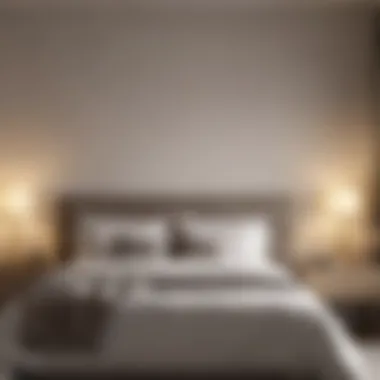
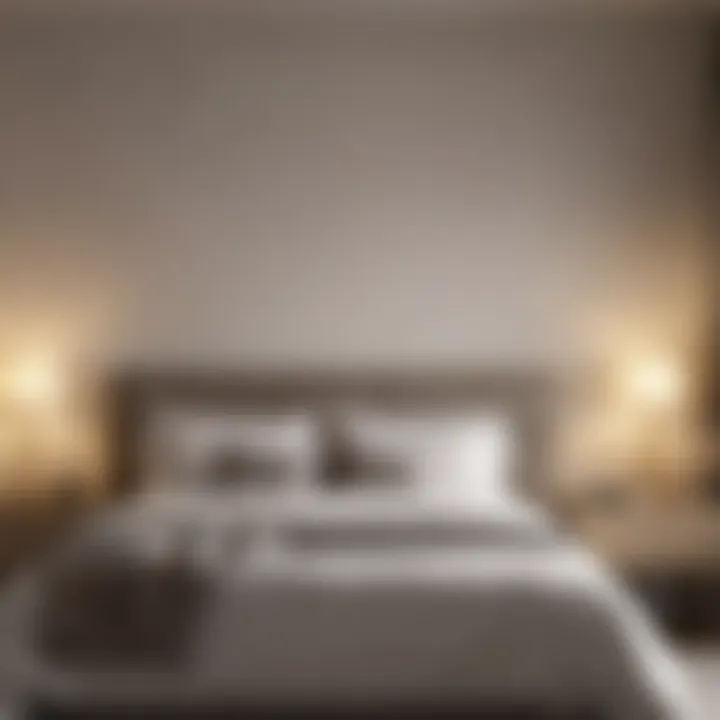
Here’s a quick comparison of the two types of bulbs:
- LED Bulbs
- Traditional Bulbs
- Energy-efficient
- Long lifespan
- Low heat output
- Versatile color options
- Higher energy consumption
- Shorter lifespan
- Greater heat production
- Limited lighting styles
Innovations in bedroom lighting technology provide us with powerful tools to not only beautify our spaces but also improve efficiency and enhance our well-being. Making informed choices between smart systems and LED options can significantly transform how we interact with light, paving the way for a more comfortable and personalized environment.
Tips for Arranging Light Fixtures in Your Bedroom
Arranging light fixtures in your bedroom is not just about placing them in various corners and calling it a day. It requires thoughtful consideration of the space's layout, the purpose of each fixture, and the ambiance you wish to cultivate. Each choice you make contributes to the overall feel of the room, playing a vital role in how the space is perceived and utilized.
By paying attention to the arrangement of your lighting, you can create a sophisticated environment that feels both cozy and functional. Here are crucial factors to keep in mind:
- Functionality: Understand what each light fixture is intended for. Is it for task lighting, like reading? Or is it more about setting a tranquil mood? By recognizing the function of each light source, you can better plan its placement.
- Atmosphere: The right arrangement helps to create a welcoming atmosphere. Consider how the light interacts with other elements in the room, such as color schemes and furniture types.
- Scale and Proportion: A large chandelier might overwhelm a small bedroom, while tiny table lamps can get lost in a spacious setting. Pay attention to sizing to make sure everything meshes well.
When you harmoniously orchestrate the light fixtures, you foster a space where comfort and elegance meet, making it an oasis for rest and rejuvenation.
Layering Light for Depth
Layering light refers to using multiple sources of light to create a textured environment that is rich and inviting. This technique often involves three levels of lighting: ambient, task, and accent.
- Ambient Light: This is the main source of illumination. It sets the baseline for visibility. Ceiling fixtures or wall sconces often serve this role by generally lighting the whole room.
- Task Light: These fixtures are essential for specific activities. Think about reading lamps next to your bed or a bright light above a desk. They guide you through practical tasks without making the space feel stark.
- Accent Light: These are the cherry on top. Use them to highlight artwork, architectural features, or decorative elements in your bedroom. Wall-mounted spotlights or small lamps can do wonders by directing the eye where you want it.
When combined thoughtfully, these light layers envelop your space in a warm embrace, striking a balance between functionality and aesthetics.
Positioning for Optimal Effect
Positioning your light fixtures requires a strategic approach that accounts for both functionality and the overall visual appeal of the room. Here are some essential tips to consider:
- Height Matters: The height at which you install light fixtures can significantly affect their effectiveness. For instance, pendants should hang low enough to create intimacy over reading spots but high enough not to obstruct views.
- Consider Shadows: Direct light can create harsh shadows. By positioning certain fixtures at varying angles, you can soften the light and encourage a more balanced distribution—this is especially crucial around mirrors.
- Balance the Space: If one side of the room has a heavy fixture, counter it with something on the opposite side for visual balance. This principle can apply to both function and aesthetics, ensuring harmony in your decorative decisions.
- Functional Zones: Break the room into zones and designate specific lighting for each. For instance, beside reading areas, you may want brighter, focused lights, while lounging zones could benefit from soft, diffused lighting.
Ultimately, the goal of proper positioning is to ensure that the right amount of light touches every corner of the room. Thoughtful arrangements allow you to optimize spaces, enhance atmosphere, and ensure that the bedroom serves its intended purpose beautifully.
Good lighting isn’t just a necessity; it’s a fundamental layer in crafting a home that reflects your unique style and functions smoothly for your daily routines.
Culmination
Reflecting on the elements discussed throughout this article, it becomes clear that choosing the right bedroom light fixtures is not merely a matter of aesthetics; it's a pivotal aspect that influences mood and comfort. The interplay of light and space can dramatically alter how one feels in their sanctuary. By selecting fixtures that not only suit personal taste but also serve functional purposes, homeowners can create an environment that promotes relaxation and restful sleep.
Recap of Key Insights on Bedroom Lighting Choices
At the heart of our discussion were various types of light fixtures, from elegant chandeliers to minimalist wall sconces. These options are essential in providing both general and task lighting while enhancing the room's overall vibe. Consider these fundamental takeaways:
- Personal Style Matched with Functionality: The choice of fixtures should reflect both aesthetic preferences and the functional needs of the space.
- Layered Lighting: Utilizing a combination of ambient, task, and accent lighting can create a more spacious and inviting atmosphere.
- Energy Considerations: Modern lighting solutions, particularly LED options, not only help in cutting down utility costs but also have a smaller carbon footprint.
Every homeowner’s goal should be finding the balance between light and shade, where illumination isn't overwhelming but rather complements and enhances the overall room decor.
Encouragement to Personalize Your Space
Every bedroom tells a story, and the lighting fixtures play a critical role in it. Dare to express your individuality! Rather than adhering strictly to trends, feel free to mix and match styles that resonate with you. Whether it’s a quirky lamp you picked up during a vacation or a sleek fixture that brings everything together, personal touches make a world of difference. It’s important to create a space that feels like home.
By taking the time to evaluate your choices and considering how your light fixtures will work within the space, you can truly transform your bedroom into a haven tailored to your preferences. This journey of personal selection not only beautifies the room but nurtures your well-being, making every night spent in your bedroom a cozy retreat.















